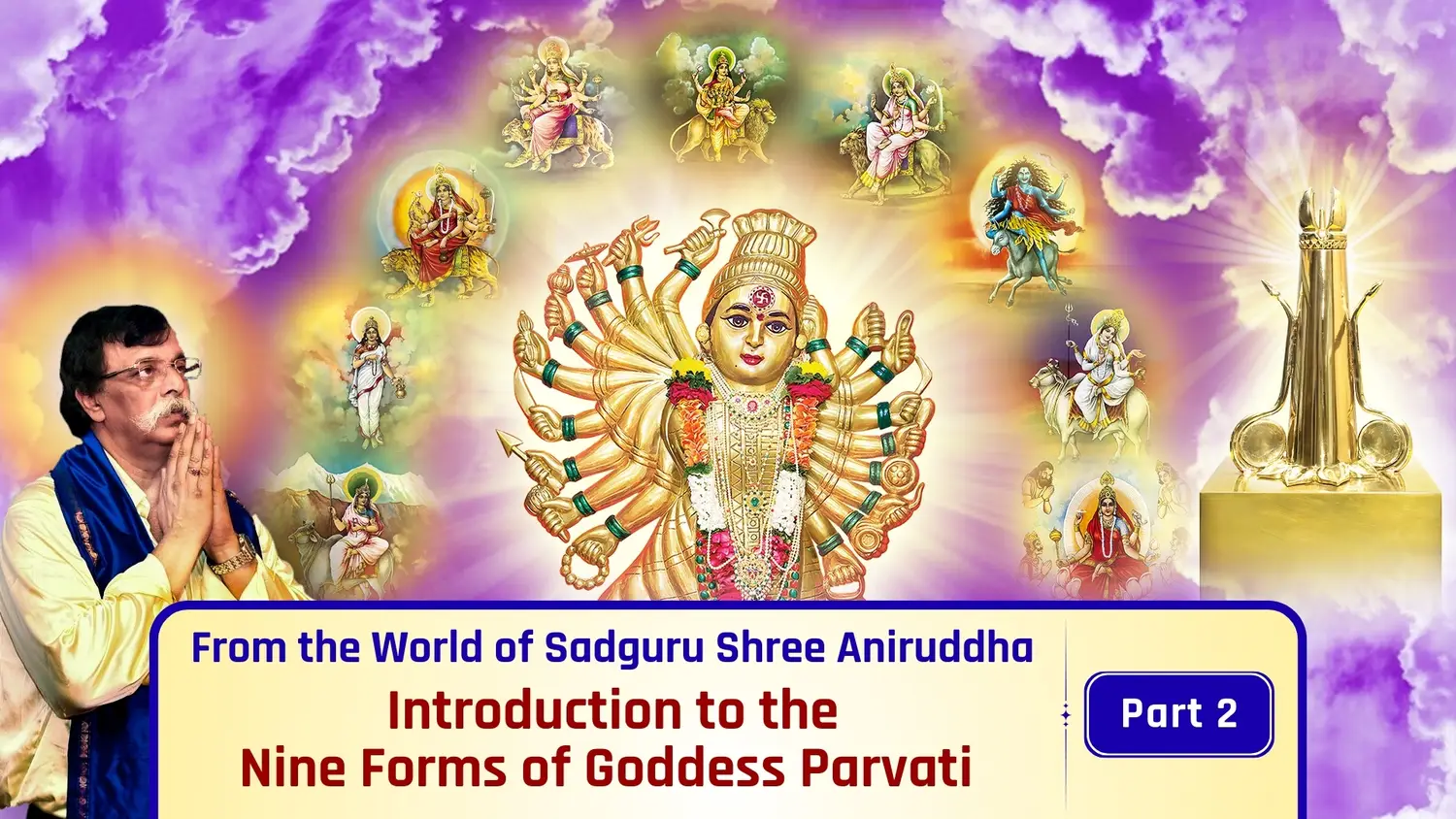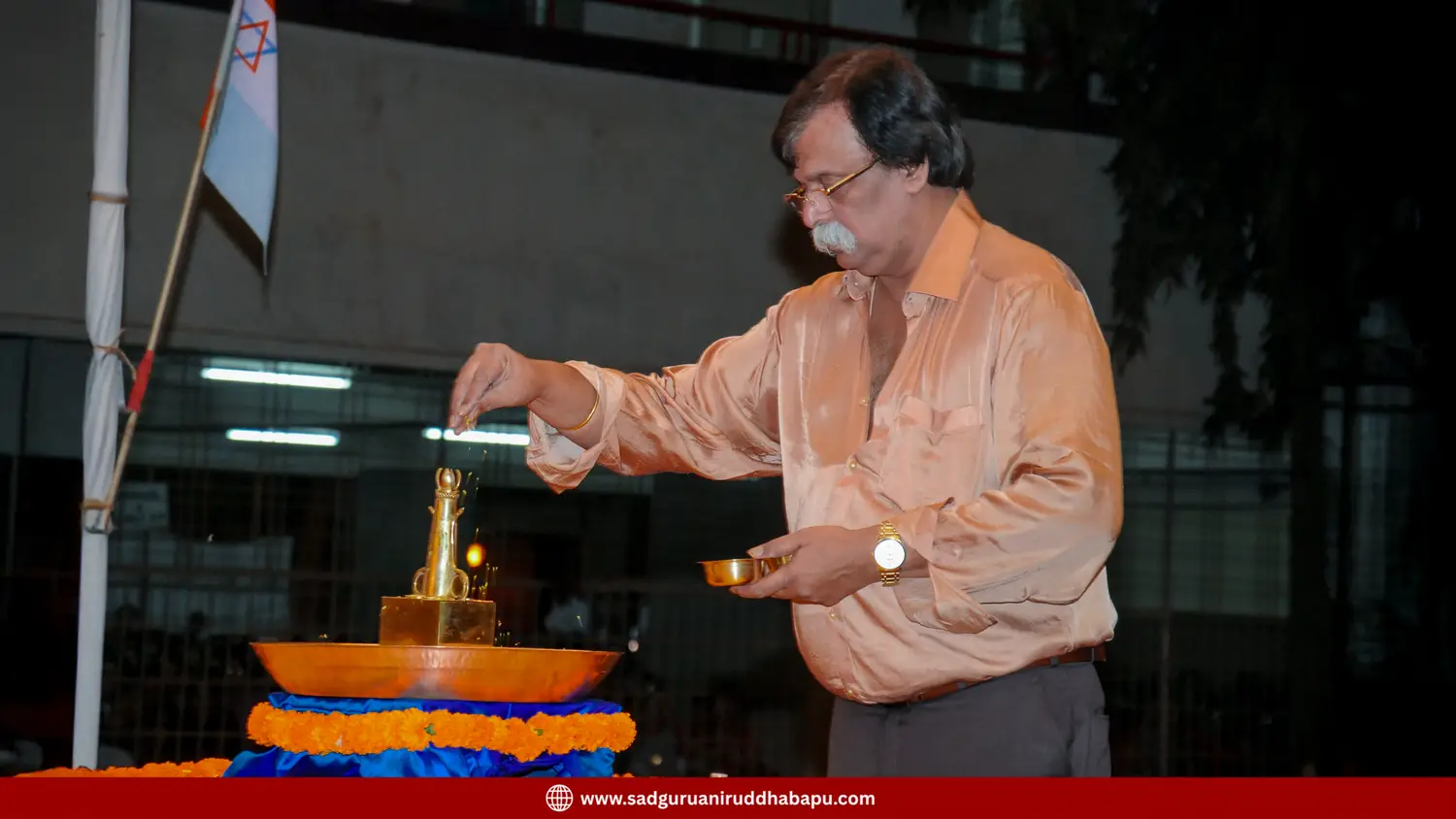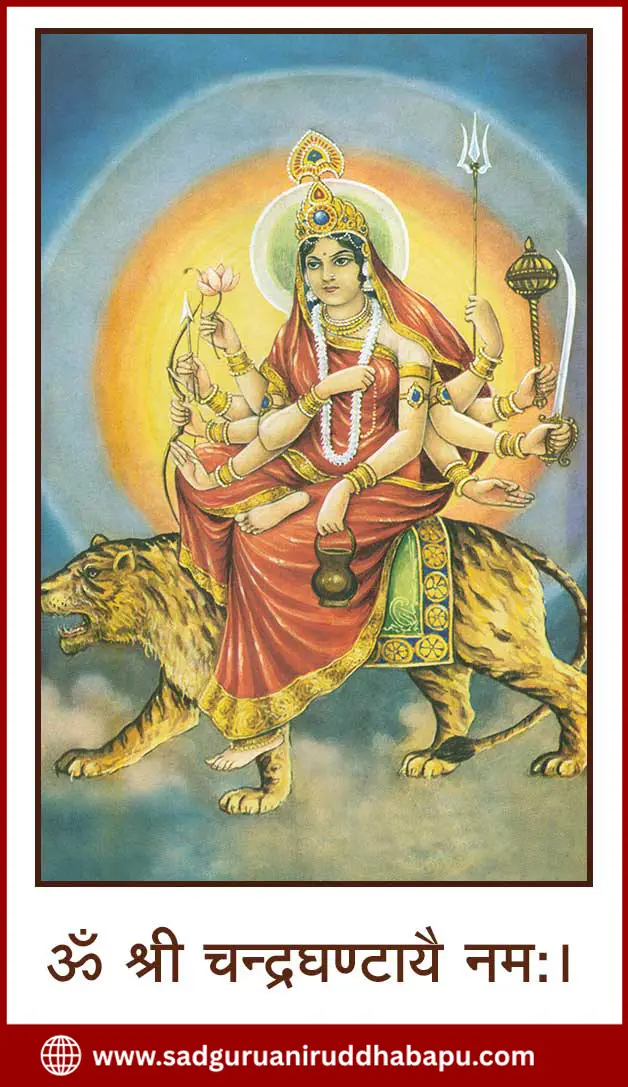Understanding the Navadurga through the spiritual canvas of Bapu's Bhav-vishwa (devotional realm) - Part 2

Reference: An editorial series, titled ‘Tulsipatra’ published in Sadguru Shree Aniruddha Bapu’ daily 'Pratyaksha' article no. 1382 & 1383.
मराठी हिंदी ગુજરાતી বাংলা తెలుగు ಕನ್ನಡ
"In Tulsipatra – 1382, Sadguru Shree Aniruddha Bapu writes –"
Lopamudra, in great admiration, called sage Gautama close to her, kissed his forehead lovingly, and said, “Dear Gautama! As Brahmarshi Kashyapa just mentioned, you are a great scholar of the science of ‘sun-rays’. But may I ask you a question?”
Sage Gautama immediately nodded respectfully in agreement, and Lopamudra asked him,
“Since you are such a great scholar of science of sun-rays, it means you must have studied all aspects of solar radiation thoroughly. Then surely, you must have also studied moon-rays, haven’t you?”
Rishi Gautama replied, “Yes, Mother.”
Lopamudra immediately asked the next question, “O Gautama! The rays of the sun are merely reflected by the moon, but their scorching heat completely disappears in the process.
This is the moon’s role.
So have you discovered the fundamental reason and principle behind this phenomenon?”
Rishi Gautama answered, “Mother! I am still a student of this subject. My study of the science of ‘sun-rays to moon-rays’ is not yet complete.”
At that moment, Parvati said to Gautama,
“O dear Gautama! You are a very intelligent, hardworking, and sincere student, teacher, and scholar. It is extremely necessary for you to discover why the rays of the sun become gentle, cool, and soothing when reflected by the moon.
Once you complete this research, the aggressiveness in your nature will vanish, and the one and only tamasic quality within you i.e. ‘uncontrolled anger’ will disappear and this you must search for yourself, because ‘research’ is the most important process that leads a human being towards perfection.”
Then Lopamudra began to speak again, “O all you eminent Shraddhavans present here! On the second step of the Shambhavi Vidya, the only means required is this single-minded yearning:
‘I want to please the Adimata, keep her pleased forever, and I want to become the true disciple and worthy son of Trivikram and serve Him always.’

For Trivikram to become our Sadguru, only two things are necessary: chanting the supreme ‘Manidweepa Mantra,’ that is, the ‘Shree Gurukshetram Mantra,’ and always remaining ‘Ambadnya’ (grateful).”
At this very second step, one has to strive for many years, and only then does the third step of the Shambhavi Vidya, that is the third realm, open for us.
The presiding deity of these first two realms (steps) of Shambhavi Vidya is Shailaputri Parvati.
These nine forms of Parvati, called the Navadurga, are sequentially the presiding deities of the eighteen realms of the Shambhavi Vidya, and there is indeed a chain of reasoning and principle behind this.
Shambhavi Vidya is the evolution that leads a human being toward perfection. It never travels by the path of revolution, and the entire life story of Parvati, the Mother of devotees, itself is the living embodiment of the Shambhavi Vidya.
In all humility, Shiva Rishi Tumburu and Devarshi Narada bowed down and asked Brahmavadini Lopamudra,
“O Lopamudra! Will you kindly explain in greater detail the life story of Parvati, the forms of these Navadurga, and their relationship with the eighteen realms of the Shambhavi Vidya?”
Lopamudra replied with a pleasant smile, “Yes, certainly. Because without learning this, even the primary understanding of Shambhavi Vidya will remain incomplete.
O eminent Shraddhavans!

After the self-immolation of Sati, this beloved of Shiva was born as ‘Parvati’ to the Himalaya, and hence she is called Shailaputri (Daughter of the Mountain). She was an ideal daughter. The perfect joy she gave to her father Himavan and mother Mena as their daughter was truly exemplary for every child in the world.
For the practitioner of the Shambhavi Vidya, too, on the second step, one has to bring joy to one’s father Trivikram.
That is why the presiding deity of the first two realms of the Shambhavi Vidya is Shailaputri Parvati. She is, therefore, the presiding deity of the first day and night of Navaratri, the Pratipada.
This same ideal daughter, Shailaputri, later undertook severe penance purely through human effort so that the all-perfect and the most superior husband, that is, Paramashiva Himself, would accept her. Her form is called Navadurga Brahmacharini, and she is the presiding deity of the third and fourth realms of the Shambhavi Vidya. She is, therefore, the presiding deity of the second day and night of Navaratri, the Dwitiya.
Because on the third and fourth steps of the Shambhavi Vidya, four Sadhanas are necessary:
(1) Solitude
(2) Contemplation upon the deity that I adore the most (Aradhya Daivat)
(3) Complete feeling of surrender at its lotus feet
(4) Readiness to make any sacrifice for it
These four qualities are attained by the contemplation and worship of Brahmacharini.
Shiva Rishi Tumburu asked respecfully,
“But which Aradhya Daivat should one select?”
Then Brahmarshi Yadnyavalkya stood up and said, “The Adimata has granted every devotee the full freedom to choose any deity from the family of Shree Chandikakul as one’s Aradhya Daivat. So, each devotee has full right to select whichever deity appeals to them, touches their heart, and feels closest to them. There is no rule that a particular deity alone must be chosen.”
Devarshi Narada asked Brahmarshi Yajnavalkya with his usual mischievousness.
“You, who are the guide of the entire life of a devotee and whom Trivikram Himself has accepted as the ‘Nityaguru,’ while practicing the Shambhavi Vidya—whom did you choose as your chosen deity?”
Understanding Narada’s playful tone, Brahmarshi Yajnavalkya replied reveredly yet with ambiguity, “You have not yet even seen the life story of my Aradhya Daivat, and soon you shall know it for you and I both are aware that Bhandasura has now taken birth.”
"In Tulsipatra – 1383, Sadguru Shree Aniruddha Bapu writes –"
The conversation between Bhaktamata (the Mother of devotees) Parvati and Sage Gautama, followed by Devarshi Narada and Brahmarshi Yadnyavalkya, was clearly heard by the Rishikumars and the Shivganas present there; however, it was not fully understood.
The statement by Brahmarshi Yajnavalkya, “Bhandasura has been born,” had left everyone astonished.
Seeing the restlessness of all present, Bhaktamata Parvati herself began to speak again:
“O Shraddhavans! Remove all thoughts and curiosity about Bhandasura from your minds. For although Bhandasura has indeed been born, he has not yet made any moves. All I will say is this—there is certainly going to be a war with Bhandasura. But before it begins, it is absolutely essential for all of you to understand the Shambhavi Vidya, and there is ample time for that.
Just as the ‘Shiva–Tripurasura battle’ represents the narrative form of the Shambhavi Vidya, similarly, the ‘battle with Bhandasura and his slaying’ represents the narrative form of the actual impact and function of the Shambhavi Vidya in human life.”
With these words of Bhaktamata Parvati, everyone’s minds once again calmed down. They then turned towards Lopamudra, eager to hear what she would say next.
Brahmavadini Lopamudra looked at Sage Gautama with a gentle smile and said, “Dear Gautama! The root source of the journey, i.e., ‘from sunrays to moonrays’ which you are about to study, is the third Navadurga, Chandraghanta herself.
This ‘Chandraghanta Parvati’ is the presiding deity of the third day and night of Navratri. She has ten arms and uses the half-moon, the moon of the pure Ashtami night, as the delicate bell adorning her hair.

The light emanating from this bell in the form of moon is also sound in nature, and the sound of this bell is composed of light waves.
Thus, this third Navadurga, Chandraghanta, embodies and demonstrates the unification of sound and light, the two fundamental expressions.
The speed of light waves is many times greater than that of sound waves.
However, this bell in the form of moon of the Navadurga is the one unique medium that brings about the effortless transformation of light waves into sound waves and sound waves into light waves.
And this is something of utmost importance for all Shraddhavans to remember forever.
For, to the extent that a person’s faith and trust in the Chandikakul are deep, to that extent this very Chandraghanta Navadurga becomes active in his life.
It is because of her that the sound of a Shraddhavan’s prayer travels at the speed of light waves, and the fruit of his prayer—namely, the blessing of the Chandikakul also reaches him at the same swift speed.
However, merely saying ‘I have complete faith in you’ with words is not enough; it must be reflected in your actions as well.
And the fifth and sixth stages of the Shambhavi Vidya are precisely the stages where faith and trust are to be proven through your actions and obedience to her words.
Hence, faith and trust are the fifth and sixth steps of the Shambhavi Vidya, and the presiding deity of both these stages is the “Navadurga Chandraghanta”.
These two steps bestow upon the Shraddhavan, the most important gift—fortitude (forbearance).
Without fortitude, a person’s life remains hollow. It is due to the lack of fortitude that one keeps straying onto the wrong path, continues to nurture one’s ego, falls into delusion, and ends up mistaking the right direction for the wrong one.
The Shraddhavan who while contemplating, worshipping, chanting, and singing the glories of their chosen deity, keeps expressing one’s faith through action, receives fortitude time and again from this very Navadurga named Chandraghanta, and this fortitude, too, comes gently and serenely, like moonlight.
It was during her marriage to Shiva that this very form of Parvati was revealed, and hence, ‘Chandraghanta’ is considered the eternal form of Parvati, the wife of Shiva.
In this ‘Chandraghanta’ form, Parvati became the eternal companion of the ParamShiva. The moment Shiva held her hand during the wedding, she smiled softly, serenely, beautifully, and with divine purity.
This smile is called ‘Ishat Hasya’ (the gentle smile), and from this very smile, countless new stars across infinite universes keep taking birth, each star first appears in the shape of an egg. That is why the fourth Navadurga is named ‘Kushmanda,’ because every universe begins first in the form of a ‘Kushmand.’
The presiding deity of the seventh and eighth stages (or steps) of the Shambhavi Vidya is Navadurga Kushmanda.
This is because, on the seventh and eighth steps of the Shambhavi Vidya, a devotee must engage in karmic penance, that is, discovering new knowledge and bringing about innovations at the human level and no creation, no innovation, is possible without the divine energy supplied by Navadurga Kushmanda.
She is the presiding deity of Navaratri’s fourth day and night, and therefore, if one begins any new auspicious endeavor on the fourth day of Navaratri, it becomes smoother and more successful.
The devotee who wishes to accomplish something superior and extraordinary in life may stay awake at night on the Navaratri night of the fourth day, reading the granthas of the Adimata, and worship her during the day.
